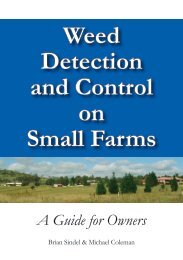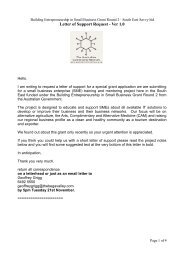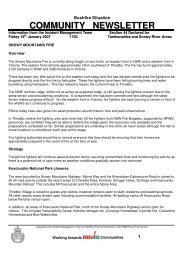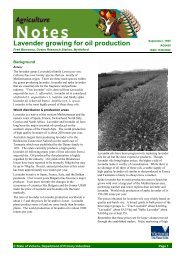September 2011 Tattler.pdf - Platypus Country
September 2011 Tattler.pdf - Platypus Country
September 2011 Tattler.pdf - Platypus Country
You also want an ePaper? Increase the reach of your titles
YUMPU automatically turns print PDFs into web optimized ePapers that Google loves.
GARDENING<br />
Planting time<br />
At this time of year the longer and brighter days make us<br />
keen to get started in the garden particularly in the<br />
vegetable plot. We are so aware of our short growing<br />
season that we often plant too early, motivated by the<br />
hope that crops will mature before cold beats us again.<br />
The two critical pieces of knowledge that should guide<br />
our actions when dealing with warm season plants are:<br />
Soil temperature controls growth above all other<br />
factors; and<br />
Night temperature has more positive effect on<br />
growth than either day temperature or sunniness.<br />
Soil Temperature. To get the earliest rise in soil<br />
temperature in Spring requires that the maximum amount<br />
of light is allowed to fall on the bare soil surface. This<br />
means that at this time of year management decisions<br />
should prioritise this one factor. To prepare for the<br />
planting of warm season crops the most effective action is<br />
clearing away mulch and ground cover such as weed and<br />
grass.<br />
Warming can be hastened by temporarily covering the<br />
area with plastic to intensify heating and reduce heat loss<br />
at night. This action requires some judgement. Plastic left<br />
on or too long may build up so much heat that soil<br />
organisms die which interferes with the soil vitality. (This<br />
is a technique called soil solarisation that is used to<br />
fumigate soil pathogens).<br />
Completely covering a large area prevents entry of water<br />
and oxygen which also reduces soil health. In a large<br />
garden bed try laying plastic in metre wide strips with a<br />
space of 20cms left open between them. This allows heat,<br />
water, oxygen and soil organisms to migrate horizontally.<br />
At Delegate School we ripened watermelons last season<br />
by leaving a black plastic 30cm square around the base of<br />
the plant. This kept the main root area warm and did not<br />
interfere with water and oxygen exchange. The runners<br />
were allowed to stretch over soil and the path made of<br />
bark chips. If we had covered the whole area with plastic,<br />
the heat generated would have been detrimental to soil<br />
and root health and the heat reflected from the surface<br />
would have cooked the vine. In addition, water pooling on<br />
the plastic surface would have surely generated fungal<br />
disease (mildew). Most importantly we restricted each<br />
vine to producing only two fruit.<br />
As the season progresses water management becomes the<br />
priority and this is when mulch comes into its own. Mulch<br />
is also useful in the peak of the summer as it holds down<br />
soil temperatures which can become so high that growth<br />
is inhibited. In our area soil heat may be a temporary<br />
negative factor in the growth of cold climate and shallow<br />
rooted plants such as camellias that are often the basis of<br />
perennial gardens in this district but is not usually of<br />
consequence to vegetable crops. If water permits<br />
maximum growth of vegetables usually occurs with a bare<br />
Susan Tocchini<br />
soil.<br />
Night Temperature. There is little that can be managed<br />
to great effect in the open garden. Placing covers etc. is<br />
time consuming whereas cloches and tunnels are growing<br />
techniques with their own specific challenges.<br />
Growing in the peak of the season and restricting planting<br />
to suitable varieties gives the best and most efficient<br />
production. Nursing crops through adverse weather<br />
conditions is time consuming and ultimately<br />
disappointing. So wait a month or six weeks to plant out<br />
the warm season crops such as tomatoes, zucchini,<br />
pumpkin, peppers and even longer for corn. In the<br />
meantime warm the soil in preparation for these and in<br />
other beds concentrate on crops that take a bit of cold like<br />
coriander, parsley, radish, lettuce, peas, spinach, carrot<br />
and potatoes etc. See Deb's comments below.<br />
<strong>September</strong> plantings<br />
Spring is in the air and the urge to get planting is very<br />
strong. Since seeds and seedlings are expensive, we need<br />
to ensure the best chance of survival for our plantings. Its<br />
rewarding to see plants emerge from the soil but heartbreaking<br />
to watch them shoot up to seed before giving us<br />
any food or going black in frost.<br />
Local conditions<br />
There is no one ‘right’ time for planting in our region<br />
with its great variation in altitude and temperature. It<br />
helps to have had experience with local conditions or to<br />
ask someone who has. Jo in Deddick can plant up to a<br />
month before I can in Cabanandra; and Bonang is<br />
doubtless later again. Goongerah may be more like<br />
Deddick, only wetter. Unfortunately our seasons aren’t<br />
longer at the other end to make up for it! Crops that can<br />
safely be planted in <strong>September</strong> in most places include:<br />
Onion and celery seedlings (too late for seed)<br />
Carrots<br />
Parsnips<br />
Beetroot<br />
Lettuce and other greens<br />
Brassicas: cabbage, cauliflower, broccoli (but<br />
remember they will have to fight the hot summer<br />
heat at about the time they are ready for harvest)<br />
Deb

















